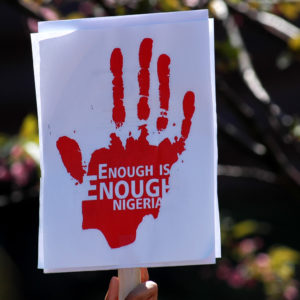Minds of the Movement
An ICNC blog on the people and power of civil resistance
by Mina YousefiFebruary 21, 2019
Anti-corruption movements, campaigns, and civic initiatives have become a familiar phenomenon in many countries, particularly in the Global South. But what specific tactics and broader approach can people utilize to turn an anti-corruption movement into real change?
Nigeria and Romania are among the numerous countries that have seen collective efforts to push governments toward more accountability and less corrupt practices. However, not all of these efforts against corruption have experienced desired outcomes. Broadly speaking, movements that have combined several different civil resistance tactics have been more productive in curbing corruption than those relying simply on street protest.
Corruption: A Multidimensional Issue
Transparency International defines corruption as the abuse of entrusted power for private gain. Shaazka Beyerle, author of Curtailing Corruption: People Power for Accountability and Justice, expands this definition, noting that corruption often involves “a complex, intertwined set of relationships, some obvious, others hidden, with established vested interests, that can operate vertically within an institution or horizontally cut across political, economic and social spheres in a society or transnationally.” Beyerle’s elaboration explains the extent to which this phenomenon affects different aspects of society.
Many studies suggest that corruption has a direct correlation with inequality in a society. This means that in a corrupt system, not only is wealth distributed unequally throughout society, but people also do not have equal access to resources such as education, health, and social welfare, which are considered to be every citizen’s rights.
That’s why many successful anti-corruption campaigns use a combination of approaches to tackle this multidimensional problem. Revealing corruption to raise public awareness, running sub-campaigns such as boycotts, stay-aways, tracking government expenditure, whistleblowing, public interest litigation, and policy scrutiny are the tactics that can collectively increase the impact of an anti-corruption movement.
The examples in Nigeria and Romania below shed light on the importance of tactical diversity—as well as particular tactics often used with significant impact—in struggling against the complex problem of corruption.
Collective Tactics Work
Nigerians have drawn global attention to their movement to combat corruption. The Creative Youth Initiative Against Corruption (CYIAC) is one of the successful anti-corruption uprisings in that country. This initiative combines several tactics: Agenda setting (which means influencing the prioritization of issues on the public agenda), stay-aways, tracking government expenditure, whistleblowing, strategic support to institutions (which means consulting the government on initiatives that benefit citizens), public interest litigation, and policy scrutiny. Altogether, these tactics constitute a comprehensive approach to combating corruption.

Nigeria's Enough is Enough campaign rallies against corruption in the country. Source: eie.ng.
Nonviolent action and other initiatives to curtail corruption have been spreading across Nigeria, as documented in a 2018 USIP report. One of the significant outcomes of these collective efforts is, according to the report, “organizations [being] able to advance innovative solutions and plans [for curbing corruption], thereby increasing the likelihood of reform adoption.”
This, of course, does not mean movements should refrain from public street actions: For example, the Enough is Enough campaign’s rallies against some government corrupt practices, have drawn hundreds of Nigerians in Abuja and Lagos. It is the strategic mixing and sequencing of street actions with other tactics that is important—so corrupt actors are less able to anticipate activists’ moves, and so they become increasingly surrounded by civic pressure.
Interaction between Publics and Elites
Romania has been suffering for decades from corruption, a central problem around which people are mobilizing and engaging after a period of limited political action. Since 1989, the transition to democracy has seen many nonviolent campaigns and movements to hold the government accountable. These groups adopted a new approach in 2012: empowering people by bringing elites—members of the political system—and the public together.
A study on four main uprisings in Romania that took place in 2012, 2013, 2015, and 2017 shows that popular pressure impacted the Romanian political establishment and brought on some noteworthy changes within the government. In a resounding achievement, a large number of Romanian activists and NGOs managed to build an organizational infrastructure to mobilize citizens. This process resulted in a great awakening in the country and many citizens realized they have a voice to question the elites.
Measuring Impacts of Anti-Corruption Organizing
Nigeria and Romania are good examples of well-planned anti-corruption movements. Nevertheless, statistics sometimes fail to capture the full picture; both countries have fallen on the TI index. The TI Index is based on “perceived levels of public sector corruption according to businesspeople and experts.” Thus, points out Beyerle, it’s not representative of overall perceptions of a general population toward corruption. She adds, “Corruption may be increasing overall in a country, but some kinds or experiences of it may decrease or at least not increase. This can involve corruption prevention rather than corruption reduction. It's a counterfactual [case] that's tough to measure.”
Fighting corruption is a societal problem that involves tackling relationships, vested interests, activities, norms, attitudes, and more. In other words, it isn't linear. Thus, to look at the impact of anti-corruption movements, campaigns, and other types of civic efforts, one must study societal changes in the months and years that follow—for traces of those movements’ expressed grievances, objectives or goals, and demands, previously considered unattainable.

Mina Yousefi
Mina Yousefi is an Iranian journalist and academic. She has been working in investigative journalism for more than 12 years focusing on civil society and governance. During the last three years, at Brandeis University (USA), she has been conducting Masters-level research on corruption in Iran and the way this phenomenon has been changing civil dynamics.
Read More